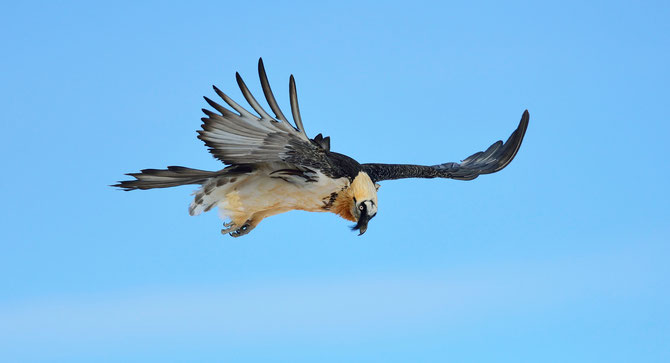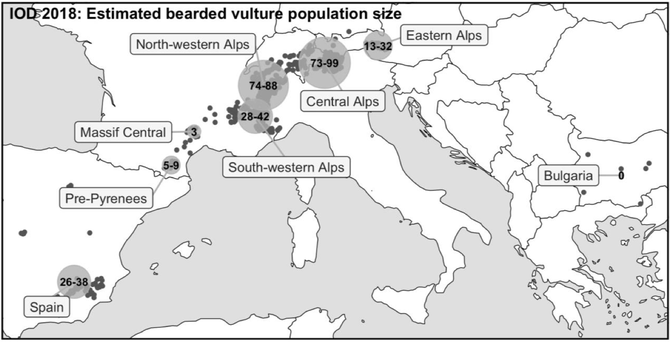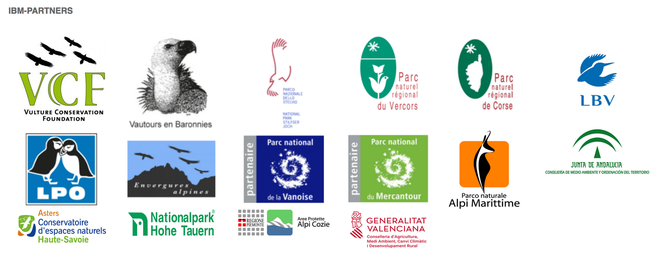
In just a month, the largest count of Bearded Vultures is taking place at the International Observation Days 2019. What are last year’s results?
Understanding the Bearded Vulture population
The International Observation Days (IOD), has become an important event for ornithologist and bird-watchers, who are fascinated by this large bird species. Last year, the IOD took place between the 6-14 October for the 13th consecutive time! The IOD covers large parts of the Alpine arc (since 2006), parts of the Massif Central (since 2012) and the eastern part of the French Pyrenees (since 2016), several regions in Spain (since 2017) and for the first time in 2018 at some selected regions in Bulgaria. This monitoring action is organised by the International Bearded Vulture Monitoring network (IBM), which is coordinated by us here at the Vulture Conservation Foundation.
The number of volunteer observers has been growing every year – last year, we had 1044 participants, that logged in 701 Bearded Vulture observations. Crossing the observation data with expert knowledge about the presence of territorial and tagged birds, last year we estimated the Bearded Vulture population size in the Alps to be between 208 and 284 birds. For the Massif Central, we counted 3 birds, 5-9 in Pre-Pyrenees in France, between 28 and 40 in Spain and none in Bulgaria.

Among the observed birds last year, 13% were identified as juveniles, 20% as immature, 7% as subadult and 55% as adult birds. Furthermore, it was possible to identify individually 55 Bearded Vultures, thus providing us valuable information on their life history.
This data is vital to help us build and improve demographic models that enable us to assess the progress of the reintroduction programmes in the five areas of Europe the species is being reintroduced and populations restocked with captive-bred birds. Furthermore, the observation days represent a big public event that helps to increase the awareness for this flagship species.
Report_IOD_2018.pdf
Adobe Acrobat Document 3.5 MB
Get Involved

Are you a vulture fan that wants to help conservationists monitor and count Europe’s rarest vulture? Join us in this year’s IOD!
The IOD is an ambitious conservation initiative that cannot be achieved without the help of the public! This year’s simultaneous count is on 12 October 2019. All over the Alps, the Massif Central, the department Aude, Andalusia and Bulgaria, we are inviting people to get involved, pick up a pair of binoculars, spend the day in the mountains, help us look for Bearded Vultures and get counting.
Through our network of organisations, there are plenty of opportunities to get involved. Please contact the regional coordinators below if you are interested in participating or contact us for any other question:
Austria
Nationalpark Hohe Tauern – ferdinand.lainer@salzburg.gv.at
France
Asters Haute-Savoie Conservatory of Natural Areas: etienne.marle@asters.asso.fr
Le Parc national du Mercantour: monique.perfus@mercantour-parcnational.fr
Parc national de la Vanoise: jerome.cavailhes@vanoise-parcnational.fr
Envergures Alpines: christian.couloumy@gmail.com
Parc naturel régional des Grands Causses: lea.giraud@lpo.fr
Parc naturel régional du Vercors: life.gypaete@pnr-vercors.fr
Vautours en Baronnies: gypaete@vautoursenbaronnies.com
Ligue pour la Protection des Oiseaux de l’Aude: yves.roullaud.aude@lpo.fr
Italy
Parco Nazionale dello Stelvio: enrico.bassi76@gmail.com
Aosta: c.chioso@regione.vda.it
Parco Naturale Alpi Marittime: fabiano.sartirana@parcoalpimarittime.it
Spain
Fundación Gypaetus: prodriguez@gypaetus.org
Switzerland
Stiftung Pro Bartgeier: franziska.loercher@swild.ch
Germany
LBV: henning.werth@lbv.de
The International Bearded Vulture Monitoring Network (IBM)

The International Bearded Vulture Monitoring Network (IBM) is a unique international collaboration led by the Vulture Conservation Foundation between national & natural parks and non-governmental organisations to coordinate the monitoring activities for European Bearded Vulture populations. Through this network, data about the Bearded Vulture in Europe is collected, shared and made available to everyone working for the conservation of the species. The IBM-network also uses this data and comes together to discuss conservation strategies and priorities for this species on an international level. There are currently 16 partners and two associated organisations part of the IBM-network.




